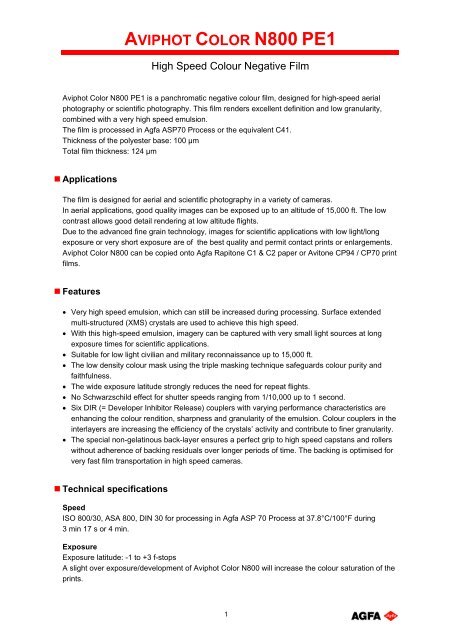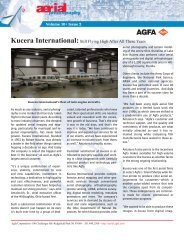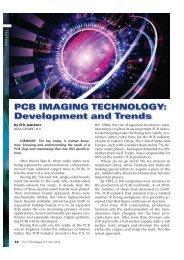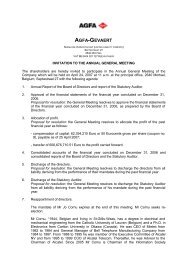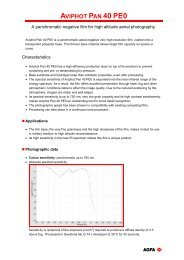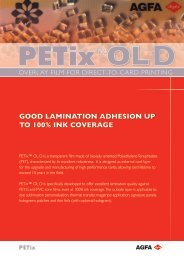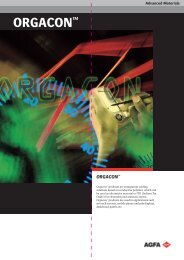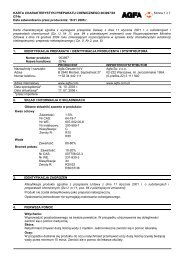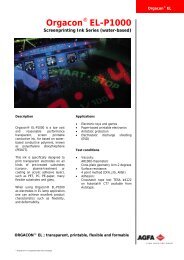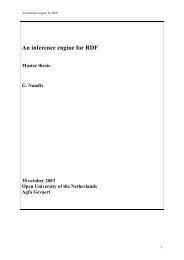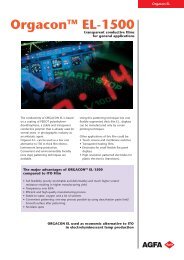AVIPHOT COLOR N400 PE1 - Agfa
AVIPHOT COLOR N400 PE1 - Agfa
AVIPHOT COLOR N400 PE1 - Agfa
Create successful ePaper yourself
Turn your PDF publications into a flip-book with our unique Google optimized e-Paper software.
<strong>AVIPHOT</strong> <strong>COLOR</strong> N800 <strong>PE1</strong><br />
High Speed Colour Negative Film<br />
Aviphot Color N800 <strong>PE1</strong> is a panchromatic negative colour film, designed for high-speed aerial<br />
photography or scientific photography. This film renders excellent definition and low granularity,<br />
combined with a very high speed emulsion.<br />
The film is processed in <strong>Agfa</strong> ASP70 Process or the equivalent C41.<br />
Thickness of the polyester base: 100 µm<br />
Total film thickness: 124 µm<br />
• Applications<br />
The film is designed for aerial and scientific photography in a variety of cameras.<br />
In aerial applications, good quality images can be exposed up to an altitude of 15,000 ft. The low<br />
contrast allows good detail rendering at low altitude flights.<br />
Due to the advanced fine grain technology, images for scientific applications with low light/long<br />
exposure or very short exposure are of the best quality and permit contact prints or enlargements.<br />
Aviphot Color N800 can be copied onto <strong>Agfa</strong> Rapitone C1 & C2 paper or Avitone CP94 / CP70 print<br />
films.<br />
• Features<br />
• Very high speed emulsion, which can still be increased during processing. Surface extended<br />
multi-structured (XMS) crystals are used to achieve this high speed.<br />
• With this high-speed emulsion, imagery can be captured with very small light sources at long<br />
exposure times for scientific applications.<br />
• Suitable for low light civilian and military reconnaissance up to 15,000 ft.<br />
• The low density colour mask using the triple masking technique safeguards colour purity and<br />
faithfulness.<br />
• The wide exposure latitude strongly reduces the need for repeat flights.<br />
• No Schwarzschild effect for shutter speeds ranging from 1/10,000 up to 1 second.<br />
• Six DIR (= Developer Inhibitor Release) couplers with varying performance characteristics are<br />
enhancing the colour rendition, sharpness and granularity of the emulsion. Colour couplers in the<br />
interlayers are increasing the efficiency of the crystals’ activity and contribute to finer granularity.<br />
• The special non-gelatinous back-layer ensures a perfect grip to high speed capstans and rollers<br />
without adherence of backing residuals over longer periods of time. The backing is optimised for<br />
very fast film transportation in high speed cameras.<br />
• Technical specifications<br />
Speed<br />
ISO 800/30, ASA 800, DIN 30 for processing in <strong>Agfa</strong> ASP 70 Process at 37.8°C/100°F during<br />
3 min 17 s or 4 min.<br />
Exposure<br />
Exposure latitude: -1 to +3 f-stops<br />
A slight over exposure/development of Aviphot Color N800 will increase the colour saturation of the<br />
prints.<br />
1
Spectral Sensitivity<br />
The curves refer to a density of 0.5 above base fog.<br />
The film is exposed to an equi-energetic spectrum. Sensitivity is reciprocal to the exposure<br />
expressed in mJ/m², required to produce the indicated density.<br />
Colour rendering/ Spectral density<br />
Triple masking technology (orange mask) is used for controlling the colour rendering.<br />
The best colour balance is obtained at standard ASP70/C41 processing.<br />
The curves show the spectral density measured on the processed image (neutral object with<br />
medium brightness), per wavelength.<br />
Standard processing.<br />
Granularity<br />
Due to the fine grain property, the Aviphot Color N800 minimises the loss of details, even when<br />
enlarged.<br />
RMS Granularity<br />
The RMS granularity measured at a diffuse visual density of 1.0 with 48 µm spot size equals RMS<br />
(x1000) = 9<br />
2
Sharpness<br />
Due to the use of the DIR technology (developer Inhibitor Release) inhibitors in the emulsion are<br />
active during development to achieve better differentiation of densities within one colour. The visual<br />
effect results in clear-cut marking and enhanced sharpness.<br />
TOC (target Object Contrast)<br />
Measured according to ANSI PH 2.33-1980<br />
TOC 1000:1 = 110 lp/mm or 220 dots/mm<br />
TOC 1.6:1 = 40 lp/mm or 80 dots/mm<br />
TOC resolution is a purely visual criterion, affected significantly by the contrast range.<br />
Colour Density Curves.<br />
Processing at 37.8 C° for 3 min15 s<br />
Processing at 37.8 C° / 4 min<br />
3
• Film structure<br />
Total film thickness: 100 µm PET + 22 µm colour layers + 2 µm back layer = 124 µm.<br />
4
• Production Guidelines<br />
Film handling<br />
Wear cotton gloves, both before and after processing the film.<br />
Avoid direct contact between emulsion and other objects like rollers to prevent scratches that can<br />
be picked-up at scanning.<br />
Avoid manipulation of freshly processed film.<br />
Handle film in low dust environments. Use an anti-static cleaning device for film before<br />
duplicating/scanning.<br />
Luggage X- Ray at airports<br />
High-speed films should never be checked in with normal luggage, but kept with your hand luggage.<br />
Visual checks are always safer. This applies in particular to high-speed films, because the<br />
sensitivity of a film to X-rays is proportional to its sensitivity to visible light.<br />
Darkroom lighting<br />
The film must be handled in complete darkness in its pre-processing stage.<br />
Exposure<br />
Recommended speed setting: 600 to 1000 ASA. To get the best possible exposure, make a series<br />
of test images representative of the exposure, flying altitude and atmospheric conditions. Use the<br />
camera that you expect to use for the task and process in the machine and under the conditions<br />
foreseen for the real job. Your best image should show no under-exposure; extreme over-exposure<br />
or over-processing may also degrade the details in the image.<br />
Filters are not required for daylight exposure.<br />
Processing<br />
Aviphot Color N800 is preferably processed in a machine filled with <strong>Agfa</strong> ASP70 chemistry.<br />
If you do not have your own aerial processor, specialised photo labs can offer a solution. They<br />
generally have a lot of experience in processing Aviphot colour film. Don’t forget to inform the flight<br />
crew about the required quality of the final result, so they can take that into account on their next<br />
sortie.<br />
• Archiving<br />
Aviphot Color N800 can be archived for a very long time, if the material has been processed in a<br />
professional way and according to the instructions. Dark fading (loss of a certain colour dye in dark<br />
storage) is due to inadequate washing and/or stabilising during processing. Light fading (loss of<br />
colour dye due to exposure to light) hastens colour deterioration. If the films are to be stored for<br />
maximum duration – i.e. centuries -, we recommend to keep them stored in a dark room and in their<br />
original plastic film containers, at a RH ranging from 30% to 50% and at a temperature of<br />
max 24 °C/75 °F. Protect the film from effects caused by harmful gases (formaldehyde-, turpentineand<br />
vapour, hydrogen sulphide or ammonia).<br />
• Shelf life<br />
Unexposed Aviphot Color N800 films should be stored in a cool and dry place, in its original<br />
packaging at a temperature below 13 °C/55 °F. The expiry date indication on the film cans refers to<br />
those conditions. The photographic properties can be kept stable in freezers (at temperatures below<br />
-10 °C/+14 °F) for an extended period of time. After removal from the freezer, the film needs to<br />
adapt to the ambient temperature for some 12 hours, before the original packaging can be opened.<br />
5
If not, some water condensation (drops) may be formed on the film especially in high RH<br />
environments. Avoid any unprotected manipulation of film at high temperatures or in extreme RH<br />
circumstances. Also keep clear from harmful gases.<br />
Exposed films are best processed immediately. The latent image drift – although small- may affect<br />
the image quality in case of long delayed processing.<br />
• Dimensional Stability of Aviphot N800<br />
Temporary dimensional changes:<br />
• Thermal coefficient of linear expansion (-20°C to +50°C): 0.0018% per °C of change.<br />
• Humidity coefficient of linear expansion (30%RH to 60% RH): 0.0024% per % RH of change.<br />
Permanent dimensional changes:<br />
• Dimensional change due to processing: 0.0014%, pre- to post-processing.<br />
• Assortment<br />
Aviphot Color N800 film is available in high speed scientific camera sizes.<br />
Other sizes (320mm – 240mm – 190mm – 126mm – 80mm – 70mm –35mm) are available with<br />
minimum ordering quantities.<br />
70 mm, 35 mm and 16 mm sizes are available in various perforation types and layout. Short and<br />
long pitch perforations are possible.<br />
Your <strong>Agfa</strong>-representative will be pleased to give you additional information.<br />
mm x m mm x ft Spool / core Perforation Order code<br />
35 x 366 35 x 1200 CNP3 core Double P/EI EFPR3<br />
70 x 366 70 x 1200 CNP3/70 Type I/EI EFPS5<br />
240 x 76 240 x 250 AH 897 None EKMY4<br />
Other sizes are available with a guaranteed minimum volume.<br />
Your <strong>Agfa</strong>-representative will be pleased to give you additional information.<br />
Subject to modifications without prior notice.<br />
AGFA, the <strong>Agfa</strong> Rhombus, <strong>Agfa</strong>color, Aviphot and Avitone are trademarks of <strong>Agfa</strong>-Gevaert N.V., Belgium.<br />
© 2009 <strong>Agfa</strong>-Gevaert N.V., B-2640 Mortsel - Belgium<br />
January 2009<br />
6


